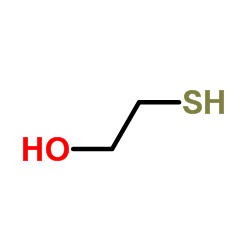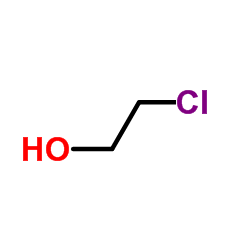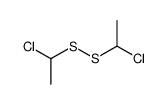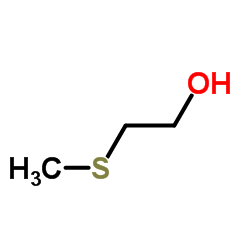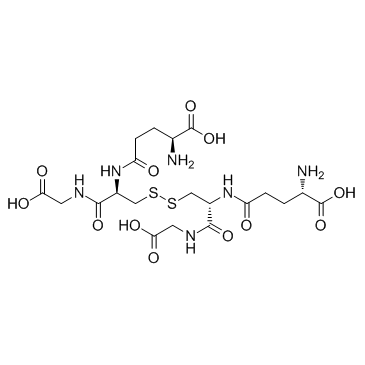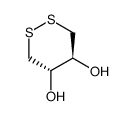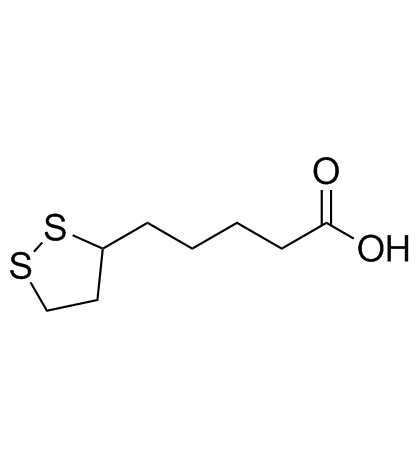1892-29-1
| 中文名 | 2-羟乙基二硫化物 |
|---|---|
| 英文名 | 2,2'-dithiodiethanol |
| 中文别名 | 2,2’-二硫二乙醇 |
| 英文别名 |
2,2'-DINAPHTHYL KETONE
MFCD00002906 ETHANOL,2,2'-DITHIODI EINECS 217-576-6 2-hydroxyethyl disulphide 2-Hydroxyethanedisulfide Diethanol disulfide Hydroxyethyl disulfide 2-Hydroxyethyl disulfide 2-(2-hydroxyethyldisulfanyl)ethanol bishydroxyethyldisulfide Dithiodiglycol 2,2'-Dithiodiethanol Ethanol,2,2'-dithiobis |
| 密度 | 1.3±0.1 g/cm3 |
|---|---|
| 沸点 | 306.5±27.0 °C at 760 mmHg |
| 熔点 | 25-27 °C(lit.) |
| 分子式 | C4H10O2S2 |
| 分子量 | 154.251 |
| 闪点 | 149.3±22.4 °C |
| 精确质量 | 154.012222 |
| PSA | 91.06000 |
| LogP | 0.51 |
| 外观性状 | 透明至淡黄色液体 |
| 蒸汽压 | 0.0±1.5 mmHg at 25°C |
| 折射率 | 1.590 |
| 储存条件 | 保持贮藏器密封、储存在阴凉、干燥的地方,确保工作间有良好的通风或排气装置 |
| 稳定性 | 如果遵照规格使用和储存则不会分解,未有已知危险反应,避免氧化物 |
| 计算化学 | 1.疏水参数计算参考值(XlogP):-0.5 2.氢键供体数量:2 3.氢键受体数量:4 4.可旋转化学键数量:5 5.互变异构体数量:无 6.拓扑分子极性表面积91.1 7.重原子数量:8 8.表面电荷:0 9.复杂度:37 10.同位素原子数量:0 11.确定原子立构中心数量:0 12.不确定原子立构中心数量:0 13.确定化学键立构中心数量:0 14.不确定化学键立构中心数量:0 15.共价键单元数量:1 |
| 更多 | 1. 性状:液体 2. 密度(g/mL,20ºC):1.261 3. 相对蒸汽密度(g/mL,空气=1):未确定 4. 熔点(ºC):25-27 5. 沸点(ºC,300pa):未确定 6. 沸点(ºC,3.5mmHg):158-163 7. 折射率:n 20/D 1.57(lit.) 8. 闪点(°F):>230 9. 比旋光度(ºF):未确定 10. 自燃点或引燃温度(ºC):未确定 11. 蒸气压(kPa,25ºC):未确定 12. 饱和蒸气压(kPa,60ºC):未确定 13. 燃烧热(KJ/mol):未确定 14. 临界温度(ºC):未确定 15. 临界压力(KPa):未确定 16. 油水(辛醇/水)分配系数的对数值:未确定 17. 爆炸上限(%,V/V):未确定 18. 爆炸下限(%,V/V):未确定 19. 溶解性:未确定 |
Synonym:2,2'-Dithiodiethano Section 2 - COMPOSITION, INFORMATION ON INGREDIENTS
Risk Phrases: 23/24/25 41 Section 3 - HAZARDS IDENTIFICATION EMERGENCY OVERVIEW
Toxic by inhalation, in contact with skin and if swallowed. Risk of serious damage to eyes.The toxicological properties of this material have not been fully investigated. Potential Health Effects Eye: May cause eye irritation. Risk of serious damage to eyes. Skin: May cause skin irritation. Toxic in contact with skin. Ingestion: May cause irritation of the digestive tract. The toxicological properties of this substance have not been fully investigated. Toxic if swallowed. Inhalation: May cause respiratory tract irritation. The toxicological properties of this substance have not been fully investigated. Toxic if inhaled. Chronic: No information found. Section 4 - FIRST AID MEASURES Eyes: Immediately flush eyes with plenty of water for at least 15 minutes, occasionally lifting the upper and lower eyelids. Get medical aid immediately. Skin: Get medical aid immediately. Immediately flush skin with plenty of water for at least 15 minutes while removing contaminated clothing and shoes. Ingestion: Wash mouth out with water. If swallowed, do not induce vomiting unless directed to do so by medical personnel. Never give anything by mouth to an unconscious person. Get medical aid. Inhalation: Get medical aid immediately. Remove from exposure and move to fresh air immediately. If not breathing, give artificial respiration. If breathing is difficult, give oxygen. Notes to Physician: Treat symptomatically and supportively. Section 5 - FIRE FIGHTING MEASURES General Information: As in any fire, wear a self-contained breathing apparatus in pressure-demand, MSHA/NIOSH (approved or equivalent), and full protective gear. During a fire, irritating and highly toxic gases may be generated by thermal decomposition or combustion. Extinguishing Media: Use water spray, dry chemical, carbon dioxide, or chemical foam. Section 6 - ACCIDENTAL RELEASE MEASURES General Information: Use proper personal protective equipment as indicated in Section 8. Spills/Leaks: Absorb spill with inert material (e.g. vermiculite, sand or earth), then place in suitable container. Clean up spills immediately, observing precautions in the Protective Equipment section. Sweep up or absorb material, then place into a suitable clean, dry, closed container for disposal. Avoid generating dusty conditions. Provide ventilation. Section 7 - HANDLING and STORAGE Handling: Wash thoroughly after handling. Do not breathe dust, vapor, mist, or gas. Do not get in eyes, on skin, or on clothing. Keep container tightly closed. Do not ingest or inhale. Use only in a chemical fume hood. Storage: Store in a cool, dry place. Store in a tightly closed container. Section 8 - EXPOSURE CONTROLS, PERSONAL PROTECTION Engineering Controls: Facilities storing or utilizing this material should be equipped with an eyewash facility and a safety shower. Use adequate ventilation to keep airborne concentrations low. Exposure Limits CAS# 1892-29-1: Personal Protective Equipment Eyes: Wear appropriate protective eyeglasses or chemical safety goggles as described by OSHA's eye and face protection regulations in 29 CFR 1910.133 or European Standard EN166. Skin: Wear appropriate protective gloves to prevent skin exposure. Clothing: Wear appropriate protective clothing to prevent skin exposure. Respirators: Follow the OSHA respirator regulations found in 29 CFR 1910.134 or European Standard EN 149. Use a NIOSH/MSHA or European Standard EN 149 approved respirator if exposure limits are exceeded or if irritation or other symptoms are experienced. Section 9 - PHYSICAL AND CHEMICAL PROPERTIES Physical State: Solid or liquid Color: after melting, clear yellow Odor: stench pH: Not available. Vapor Pressure: Not available. Viscosity: Not available. Boiling Point: 158 - 163 deg C @3.5mmHg Freezing/Melting Point: 25 - 27 deg C Autoignition Temperature: Not available. Flash Point: > 110 deg C (> 230.00 deg F) Explosion Limits, lower: Not available. Explosion Limits, upper: Not available. Decomposition Temperature: Solubility in water: Soluble. Specific Gravity/Density: 1.288 Molecular Formula: C4H10O2S2 Molecular Weight: 154.25 Section 10 - STABILITY AND REACTIVITY Chemical Stability: Stable. Conditions to Avoid: Excess heat. Incompatibilities with Other Materials: Strong oxidizing agents, acid chlorides, acid anhydrides. Hazardous Decomposition Products: Carbon monoxide, oxides of sulfur, carbon dioxide. Hazardous Polymerization: Will not occur. Section 11 - TOXICOLOGICAL INFORMATION RTECS#: CAS# 1892-29-1: KK7525000 LD50/LC50: CAS# 1892-29-1: Oral, rat: LD50 = 173 mg/kg. Carcinogenicity: 2-Hydroxyethyl disulfide, tech. - Not listed by ACGIH, IARC, or NTP. Other: See actual entry in RTECS for complete information. Section 12 - ECOLOGICAL INFORMATION Section 13 - DISPOSAL CONSIDERATIONS Dispose of in a manner consistent with federal, state, and local regulations. Section 14 - TRANSPORT INFORMATION IATA Shipping Name: TOXIC SOLIDS, ORGANIC, N.O.S. Hazard Class: 6.1 UN Number: 2811 Packing Group: III IMO Shipping Name: TOXIC SOLIDS, ORGANIC, N.O.S. Hazard Class: 6.1 UN Number: 2811 Packing Group: III RID/ADR Shipping Name: TOXIC SOLIDS, ORGANIC, N.O.S. Hazard Class: 6.1 UN Number: 2811 Packing group: III Section 15 - REGULATORY INFORMATION European/International Regulations European Labeling in Accordance with EC Directives Hazard Symbols: T Risk Phrases: R 23/24/25 Toxic by inhalation, in contact with skin and if swallowed. R 41 Risk of serious damage to eyes. Safety Phrases: S 26 In case of contact with eyes, rinse immediately with plenty of water and seek medical advice. S 28A After contact with skin, wash immediately with plenty of water. S 36/37/39 Wear suitable protective clothing, gloves and eye/face protection. S 38 In case of insufficient ventilation, wear suitable respiratory equipment. S 45 In case of accident or if you feel unwell, seek medical advice immediately (show the label where possible). WGK (Water Danger/Protection) CAS# 1892-29-1: No information available. Canada CAS# 1892-29-1 is listed on Canada's NDSL List. CAS# 1892-29-1 is not listed on Canada's Ingredient Disclosure List. US FEDERAL TSCA CAS# 1892-29-1 is listed on the TSCA inventory. SECTION 16 - ADDITIONAL INFORMATION N/A |
|
毒理学数据: 1、急性毒性:大鼠经口LD50:173mg /kg;小鼠经腹腔LD50:100mg/kg; 生态学数据: 对水是稍微有危害的不要让未稀释或大量的产品接触地下水、水道或者污水系统,若无政府许可,勿将材料排入周围环境 CHEMICAL IDENTIFICATION
HEALTH HAZARD DATAACUTE TOXICITY DATA
|
| 符号 |


GHS05, GHS06 |
|---|---|
| 信号词 | Danger |
| 危害声明 | H301-H318 |
| 警示性声明 | P280-P301 + P310-P305 + P351 + P338 |
| 个人防护装备 | Eyeshields;Faceshields;full-face respirator (US);Gloves;multi-purpose combination respirator cartridge (US);type ABEK (EN14387) respirator filter |
| 危害码 (欧洲) | T:Toxic; |
| 风险声明 (欧洲) | R23/24/25 |
| 安全声明 (欧洲) | S26-S39-S45 |
| 危险品运输编码 | UN 2811 6.1/PG 3 |
| WGK德国 | 3 |
| RTECS号 | KK7525000 |
| 包装等级 | III |
| 危险类别 | 6.1 |
| 海关编码 | 2930909090 |
| 上游产品 9 | |
|---|---|
| 下游产品 9 | |
| 海关编码 | 2930909090 |
|---|---|
| 中文概述 | 2930909090. 其他有机硫化合物. 增值税率:17.0%. 退税率:13.0%. 监管条件:无. 最惠国关税:6.5%. 普通关税:30.0% |
| 申报要素 | 品名, 成分含量, 用途 |
| Summary | 2930909090. other organo-sulphur compounds. VAT:17.0%. Tax rebate rate:13.0%. . MFN tariff:6.5%. General tariff:30.0% |



